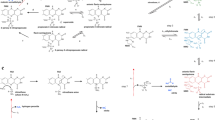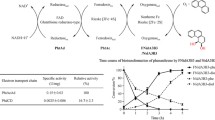Abstract
Pollutants are frequently found as mixtures yet it is difficult to engineer enzymes with broad substrate ranges on aromatics. Inspired by the archetypal nitroarene dioxygenase, which shares its electron transport with a salicylate monooxygenase, we have created an innovative and general approach to expand the substrate range of dioxygenase enzymes in a single cell. We have developed here a series of novel, hybrid dioxygenase enzymes that function with a single ferredoxin reductase and ferredoxin that are used to transport two electrons from nicotinamide adenine dinucleotide to the two independent terminal oxygenases. Each independent alpha-oxygenase may then be used simultaneously to create orthric enzymes that degrade mixtures of environmental pollutants. Specifically, we created a hybrid dioxygenase system consisting of naphthalene dioxygenase/dinitrotoluene dioxygenase to simultaneously degrade 2,4-dinitrotoluene and naphthalene (neither enzyme alone had significant activity on both compounds) and dinitrotoluene dioxygenase/nitrobenzene dioxygenase to simultaneously degrade the frequently encountered 2,4,6-trinitrotoluene reduction products 2-amino-4,6-dinitrotoluene and 4-amino-2,6-dinitrotoluene.



Similar content being viewed by others
References
ATSDR (2004) Public Health Assessment Volunteer Army Ammunition Plant Chattanooga, Hamilton County, Tennessee. Agency for Toxic Substances and Disease Registry, Atlanta, GA
Barriault D, Sylvestre M (1999) Functionality of biphenyl 2,3-dioxygenase components in naphthalene 1,2-dioxygenase. Appl Microbiol Biotechnol 51:592–597
Canada KA, Iwashita S, Shim H, Wood TK (2002) Directed evolution of toluene ortho-monooxygenase for enhanced 1-naphthol synthesis and chlorinated ethene degradation. J Bacteriol 184:344–349
Colbert CL, Couture MM-J, Eltis LD, Bolin JT (2000) A cluster exposed: structure of the Rieske ferredoxin from biphenyl dioxygenase and the redox properties of Rieske Fe-S proteins. Structure 8:1267–1278
Erickson BD, Mondello FJ (1993) Enhanced biodegradation of polychlorinated biphenyls after site-directed mutagenesis of a biphenyl dioxygenase gene. Appl Environ Microbiol 59:3858–3862
Fuenmayor SL, Lemoine VR (1992) Characterization of polycyclic aromatic hydrocarbons degradative soil Pseudomonas. Acta Cient Venez 43:349–354
Fuenmayor SL, Wild M, Boyes AL, Williams PA (1998) A gene cluster encoding steps in conversion of naphthalene to gentisate in Pseudomonas sp. strain U2. J Bacteriol 180:2522–2530
Gantz T (1993) Early Greek myth: a guide to literary and artistic sources. The Johns Hopkins University Press, Baltimore, pp 133–134
Green RD (1998) Five year review: Wamchem superfund site Beaufort, South Carolina. Environmental Protection Agency, Atlanta, Georgia, pp 1–15
Howe-Grant M (1991) In: Howe-Grant M (ed) Kirk–Othmer encyclopedia of chemical technology. Wiley-Interscience Publishers, New York, pp 133–152
Johnson GR, Smets BF, Spain JC (2001) Oxidative transformation of aminodinitrotoluene isomers by multicomponent dioxygenases. Appl Environ Microbiol 67:5460–5466
Johnson GR, Jain RK, Spain JC (2002) Origins of the 2,4-dinitrotoluene pathway. J Bacteriol 184:4219–4232
Johnson LR, Davenport R, Balbach H, Schaeffer DJ (1994) Phototoxicity 3. Comparative toxicity of trinitrotoluene and aminodinitrotoluenes to Daphnia magna, Dugesia dorotocephala, and sheep erythrocytes. Ecotoxicol Environ Saf 27:34–49
Keenan BG, Leungsakul T, Smets BF, Wood TK (2004) Saturation mutagenesis of Burkholderia cepacia R34 2,4-dinitrotoluene dioxygenase at DntAc valine 350 for synthesizing nitrohydroquinone, methylhydroquinone, and methoxyhydroquinone. Appl Environ Microbiol 70:3221–3222
Keenan BG, Leungsakul T, Smets BF, Mori M, Henderson DE, Wood TK (2005) Protein engineering of the archetypal nitroarene dioxygenase of Ralstonia sp. strain U2 for activity on aminonitrotoluenes and dinitrotoluenes through alpha-subunit residues leucine 225, phenylalanine 350, and glycine 407. J Bacteriol 187:3302–3310
Keith LH, Telliard WA (1979) Priority pollutants. Environ Sci Technol 13:416–423
Kumamaru T, Suenaga H, Mitsuoka M, Watanabe T, Furukawa K (1998) Enhanced degradation of polychlorinated biphenyls by directed evolution of biphenyl dioxygenase. Nat Biotechnol 16:663–666
Lee K (1998) Involvement of electrostatic interactions between the components of toluene dioxygenase from Pseudomonas putida F1. J Microbiol Biotechnol 8:416–421
Lessner DJ, Johnson GR, Parales RE, Spain JC, Gibson DT (2002) Molecular characterization and substrate specificity of nitrobenzene dioxygenase from Comamonas sp. strain JS765. Appl Environ Microbiol 68:634–641
Leungsakul T, Keenan BG, Yin H, Smets BF, Wood TK (2005) Saturation mutagenesis of 2,4-DNT dioxygenase of Burkholderia sp. strain DNT for enhanced dinitrotoluene degradation. Biotechnol Bioeng 92:510–517
Mori M, Shoji M, Sayama M, Kondo T, Inoue M, Kodaira K (2000) Secondary metabolism of dinitrobenzyl glucuronide related to production of genotoxic compounds of dinitrotoluene in male Wistar rat. J Health Sci 46:329–335
Nam J-W, Noguchi H, Fujimoto Z, Mizuno H, Ashikawa Y, Abo M, Fushinobu S, Kobashi N, Wakagi T, Iwata K et al (2005) Crystal structure of the ferredoxin component of carbazole 1,9a-dioxygenase of Pseudomonas resinovorans strain CA10, a novel Rieske non-heme iron oxygenase system. Proteins 58:779–789
Nishino SF, Spain JC (1995) Oxidative pathway for the biodegradation of nitrobenzene by Comamonas sp. strain JS765. Appl Environ Microbiol 61:2308–2313
Nishino SF, Paoli GC, Spain JC (2000) Aerobic degradation of dinitrotoluenes and pathway for bacterial degradation of 2,6-dinitrotoluene. Appl Environ Microbiol 66:2139–2147
Parales JV, Parales RE, Resnick SM, Gibson DT (1998a) Enzyme specificity of 2-nitrotoluene 2,3-dioxygenase from Pseudomonas sp. strain JS42 is determined by the C-terminal region of the alpha-subunit of the oxygenase component. J Bacteriol 180:1194–1199
Parales RE, Emig MD, Lynch NA, Gibson DT (1998b) Substrate specificities of hybrid naphthalene and 2,4-dinitrotoluene dioxygenase enzyme systems. J Bacteriol 180:2337–2344
Parales RE, Lee K, Resnick SM, Jiang H, Lessner DJ, Gibson DT (2000a) Substrate specificity of naphthalene dioxygenase: effect of specific amino acids at the active site of the enzyme. J Bacteriol 182:1641–1649
Parales RE, Resnick SM, Yu C-L, Boyd DR, Sharma ND, Gibson DT (2000b) Regioselectivity and enantioselectivity of naphthalene dioxygenase during arene cis-dihydroxylation: control by phenylalanine 352 in the alpha-subunit. J Bacteriol 182:5495–5504
Parales RE, Huang R, Yu C-L, Parales JV, Lee FKN, Lessner DJ, Ivkovic-Jensen MM, Liu W, Friemann R, Ramaswamy S and others (2005) Purification, characterization, and crystallization of the components of the nitrobenzene and 2-nitrotoluene dioxygenase enzyme systems. Appl Environ Microbiol 71:3806–3814
Rui L, Reardon K, Wood TK (2005) Protein engineering of toluene ortho-monooxygenase of Burkholderia cepacia G4 for regiospecific hydroxylation of indole to form various indigoid compounds. Appl Microbiol Biotechnol 66:422–429
Sambrook J, Fritsch EF, Maniatis T (1989) Molecular Cloning, A Laboratory Manual. Cold Spring Harbor Laboratory Press, Cold Spring Harbor, NY
Spanggord RJ, Spain JC, Nishino SF, Mortelmans KE (1991) Biodegradation of 2,4-dinitrotoluene by a Pseudomonas sp. Appl Environ Microbiol 57:3200–3205
Stohs SJ, Ohia S, Bagchi D (2002) Naphthalene toxicity and antioxidant nutrients. Toxicology 180:97–105
Suen WC, Haigler BE, Spain JC (1996) 2,4-Dinitrotoluene dioxygenase from Burkholderia sp. strain DNT: similarity to naphthalene dioxygenase. J Bacteriol 178:4926–4934
Sylvestre M, Sirois M, Hurtubise Y, Bergeron J, Ahmad D, Shareck F, Barriault D, Guillemette I, Juteau JM (1996) Sequencing of Comamonas testosteroni strain B-356-biphenyl/chlorobiphenyl dioxygenase genes: evolutionary relationships among gram-negative bacterial biphenyl dioxygenases. Gene 174:195–202
Taira K, Hirose J, Hayashida S, Furukawa K (1992) Analysis of bph operon from the polychlorinated biphenyl-degrading strain of KF707. J Biol Chem 267:4844–4853
Whiteway J, Koziarz P, Veall J, Sandhu N, Kumar P, Hoecher B, Lambert IB (1998) Oxygen-insensitive nitroreductases: analysis of the roles of nfsA and nfsB in development of resistance to 5-nitrofuran derivatives in Escherichia coli. J Bacteriol 180:5529–5539
Yin H, Wood TK, Smets BF (2005) Reductive transformation of TNT by Escherichia coli: pathway description. Appl Microbiol Biotechnol 67:397–404
Zylstra GJ, Gibson DT (1989) Toluene degradation by Pseudomonas putida F1. J Biol Chem 264:14940–14946
Acknowledgements
This study was supported by the National Science Foundation (BES-0114126). We thank P. A. Williams for plasmid pWWF6, I. B. Lambert for E. coli JVQ2, J. C. Spain for 4M5NC, 3A4M5NC, and for plasmid pJS765, A. Fishman for her assistance with the HPLC analyses, and M. Thompson for his assistance with the GC-MS analyses.
Author information
Authors and Affiliations
Corresponding author
Rights and permissions
About this article
Cite this article
Keenan, B.G., Wood, T.K. Orthric Rieske dioxygenases for degrading mixtures of 2,4-dinitrotoluene/naphthalene and 2-amino-4,6-dinitrotoluene/4-amino-2,6-dinitrotoluene. Appl Microbiol Biotechnol 73, 827–838 (2006). https://doi.org/10.1007/s00253-006-0538-8
Received:
Revised:
Accepted:
Published:
Issue Date:
DOI: https://doi.org/10.1007/s00253-006-0538-8



